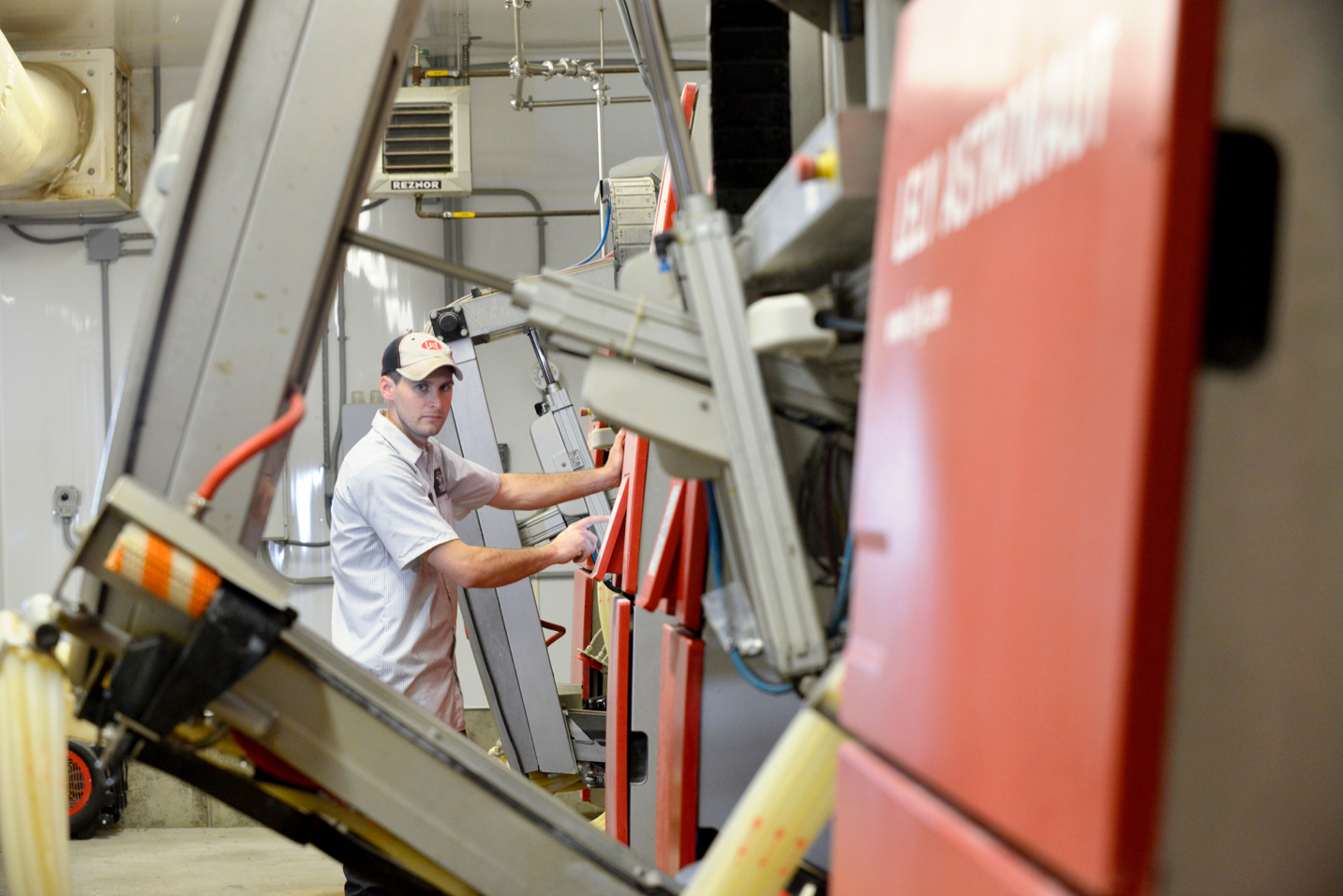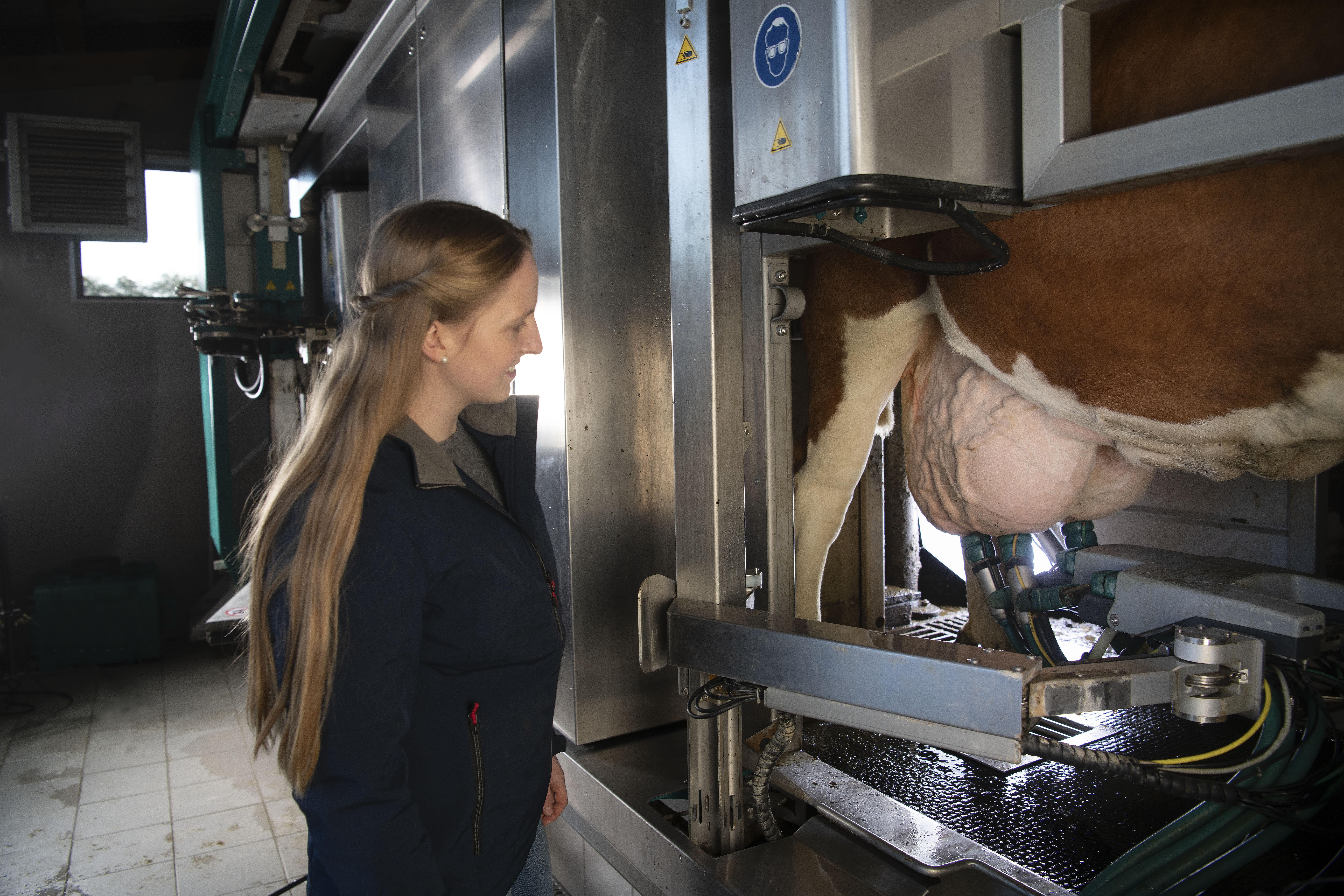“Udder balance is the average difference in udder depth between the rear udder and the fore udder,” explains Niek Meijer. The higher the breeding value, the higher the rear quarters relative to the fore quarters. “But you don’t want the rear quarters to be very high relative to the fore quarters, as the robot will then find it difficult to attach,” says Meijer. “Conversely, you don’t want the rear quarters to be deeper than the fore quarters. Udder balance is therefore an optimum trait.”
In recent years, the average difference in udder depth between the rear and fore quarters has gradually increased, Meijer comments. For example, the difference in black-and-white Holstein heifers in 2014 was 18 millimetres, whilst in 2022 that had increased to 23 millimetres.
There is also a difference between breeds. In Holstein heifers, the difference between fore and rear quarters between 2020 and 2022 averaged 21.2 millimetres. The Jerseys followed with a difference of 7.2 millimetres, whilst in Fleckvieh heifers, the difference was 2.3 millimetres. In the MRIJ heifers, the udder balance was even negative: the rear udder was 2.2 millimetres deeper than the fore udder.
The robot data also clearly show that the difference between the fore and rear udder in Holsteins becomes smaller the older the cows become. “That is also evident in later higher lactations, although the decrease seems to level off slightly in later lactations,” says Meijer.
CRV shows the breeding value for udder balance, just like the other traits, on a relative scale, with an average of 100 and a distribution of 4.
In April, not all bulls will be given a breeding value for udder balance based on robot data. Bulls without daughters with robot data – such as genomic bulls, or bulls imported from abroad – are given a breeding value for udder balance based on their genomic breeding values for the other udder traits and parent information, Meijer adds. “We expect that these bulls will have their own genomic breeding value for udder balance in December.”’
Summary
- As from April, CRV will calculate the breeding value milking speed based on robot data.
- As from April, CRV will publish the new udder trait udder balance, the starting point for which are the teat coordinates gathered by the milking robot.
- Henceforth, the base will be adjusted annually instead of once every five years.
- The breeding values for pregnancy rate cows and maiden heifers will form part of the fertility index.
- The breeding values for direct calving ease will be more stable, with a higher level of reliability.
Teat coordinates in breeding values
When attaching the teat cups, a milking robot uses teat coordinates. These specify the distance from the teats relative to the floor, the robot arm and an imaginary midline straight through the udder. As from April, CRV will include these data in the breeding value estimation, to calculate the breeding value udder balance, among other things.
Fertility and direct calving ease change slightly
In April, the indexes fertility and direct calving ease will change slightly. This means that the breeding value pregnancy rate cows and pregnancy rate maiden heifers will be added to the fertility index. “These additions will give the index a clearer picture of the effect of the bull on fertility,” says Gerben de Jong, head of the Animal Evaluation Unit (AEU) department of Cooperation CRV.
AEU includes both the breeding value pregnancy rate for cows and that for maiden heifers in the fertility index, because there isn’t a high correlation between these two breeding values. “The breeding value pregnancy rate cows measures something else than in maiden heifers,” says De Jong. According to him, it is an additional benefit that more attention is therefore paid to the fertility of maiden heifers. “We see a positive genetic trend for fertility in cows, but it remains at the same level for maiden heifers. It is good that more attention is being paid to this.”
Besides the breeding values for pregnancy rate cows and maiden heifers, the breeding value interval between first and last insemination (IFL) and the breeding value interval between calving and first insemination (ICI) form part of the fertility index.
From now on, in the breeding value estimation for direct calving ease, AEU will take inbreeding into account. The heritabilities for birth traits will also be updated and AEU is increasing the number of observations for direct calving ease per class on a farm. “We currently compare observations from ten consecutive calvings. We will soon be comparing the observations of all calvings within a year,” De Jong explains. This is possible, among other things, because the data collection method has been adjusted. “In the past, livestock farmers recorded the direct calving ease of test bull daughters on charts. Now, via management systems, a lot more data are available about direct calving ease. This ensures that the breeding value direct calving ease becomes more stable and slightly more reliable.”
Base adjustment annually instead of once every five years
This has been happening for some time in countries like Canada and France, but henceforth the Netherlands and Flanders will also adjust the base annually. To date, base adjustment took place once every five years. “We can see that by applying genomic selection, the genetic trend has doubled. Adjusting the base once every five years therefore results in significant changes,” says Gerben de Jong, head of the Animal Evaluation Unit department at Cooperation CRV. “By adjusting the base annually from now on, adjustments will be more gradual.”
The latest base adjustment took place in 2020. Since then, the Dutch and Flemish cows have made progress on several fronts, as shown by table 1. Among other things, they improved their breeding values fertility (+1.3 for black-and-white and +1.6 for red-and-white) and foot health (+1.4 for black-and-white, +1.5 for red-and-white).
For conformation, the cows mainly made progress for the udder and feet and legs, both of which are also taken into account in the NVI. CRV also adjusts the base for production. For kilograms of milk, the red-and-white (+331) is progressing slightly faster than the black-and-white (+289). For kilograms of fat and protein, the black-and-white (+26) have an advantage over the red-and-white (+23).
Because of the base adjustment, the breeding values of the bulls are a better indication of the added value compared to the current cow population. A sample calculation based on the bull Weelder Esperanto shows what effect the base adjustment has on the breeding values of a bull (table 2). In December, Esperanto came in at 321 NVI. With the base adjustment, that 321 minus 69 would equal 252 NVI. His milk output inheritance would go from +1598 to +1309, whilst his breeding value fertility would be 104 instead of 105.
At the same time, CRV is also adjusting the base dual purpose. In the current breeding value estimation, cows with 75 percent MRIJ genes form the base. As from April, those are cows with at least 87 percent MRIJ genes. “Among the cows that determined the base, there were still a reasonable number with 25 percent Holstein blood,” explains De Jong. “They had a significant impact on production, because of which MRIJ bulls and MRIJ cows had trouble obtaining a positive production breeding value. We are now adjusting that.”
Table 1 – Base adjustment for black-and-white, red-and-white and dual purpose
trait | milking goal black | milking goal red | dual purpose |
NVI | –69 | –63 | –35 |
Inet | –82 | –76 | 4 |
kg milk | –289 | –331 | 13 |
kg fat | –14 | –12 | –1 |
kg protein | –12 | –11 | 1 |
lifespan | –157 | –110 | 83 |
fertility | –1.3 | –1.6 | –0.7 |
foot health | –1.4 | –1.5 | 0.6 |
udder health | –1.3 | –1.2 | –0.9 |
saved feed costs for maintenance | 10 | 13 | 3 |
frame | –0.4 | –0.4 | 0.0 |
type | –0.9 | –1.2 | –0.3 |
udder | –2.5 | –2.7 | –1.6 |
feet and legs | –2.0 | –1.1 | –1.2 |
total conformation | –2.6 | –2.4 | –1.3 |
Table 2 – Breeding values Weelder Esperanto, with and without base adjustment (breeding values December as starting point)
Trait | current | after base adjustment |
NVI | 321 | 252 |
kg milk | +1598 | +1309 |
lifespan | +674 | +517 |
fertility | 105 | 104 |
total conformation | 109 | 106 |



